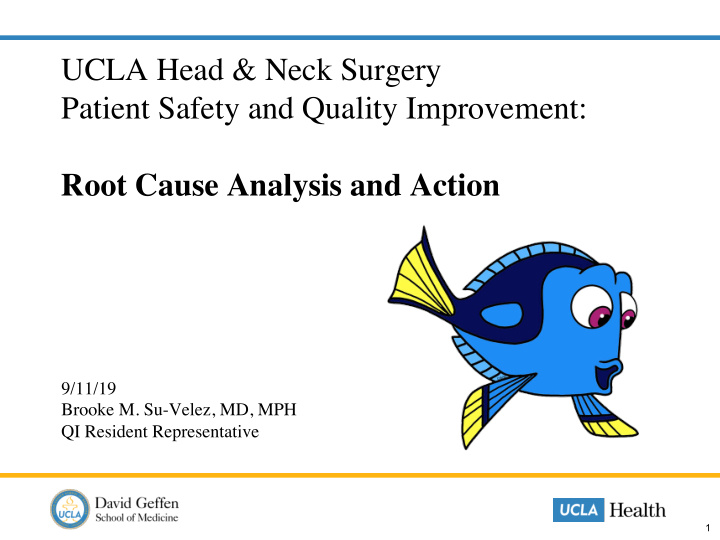



UCLA Head & Neck Surgery Patient Safety and Quality Improvement: Root Cause Analysis and Action 9/11/19 Brooke M. Su-Velez, MD, MPH QI Resident Representative 1
2
The Quadruple Aim 3
Goals of PS/QI 1. Organizational culture of safety Encouraging questions and concerns • Accountability • Negotiation and communication • 2. Learning systems and improvement • Measurement and transparency • Continuous learning • Evidence-based practices 4
Swiss cheese model of accident causation • Harm is caused by a series of systemic failures in the presence of hazard. • A front-line provider may be cause of the active error, but the real root causes of the error have often been present within the system for a long time. 5
6
Root Cause Analysis Factors that influence health care outcomes: • Institutional context • Organizational and management factors • Work environment • Team factors • Individual staff members • Task factors • Patient characteristics • There can be more than one root cause • Analysis allows for targeted action 7
Five Whys • Why did the patient receive the wrong medication? The nurse did not complete patient identification. Why? • The patient did not have a wristband. Why? • The wristband had been removed for a procedure and not replaced. Why? • The printer for the wristbands was not working. Why? • ROOT CAUSE: The staff needed to support IT had been reduced and was overworked. 8
RCA Steps 1. Understand what happened, how, and when • Flow diagram 2. Identify any gaps in knowledge 3. Collect more information • Cause and effect (fishbone) diagram • Literature search 4. Create a causal statement 5. Action plan 9
RCA – Fishbone Diagram 10
Causal Statement The cause : “This happened…” The effect : “…which led to something else happening…” The event: “…which caused this undesirable outcome.” • Clearly show the cause and effect relationship. • Use specific and accurate descriptors for what occurred. • Human error must have a preceding cause. • Violations of procedure are not a cause and must have a preceding cause. • Failure to act is only causal when there is a pre-existing duty to act. 11
RCA Steps 1. Understand what happened, how, and when, • Flow diagram 2. Identify any gaps in knowledge 3. Collect more information • Cause and effect (fishbone) diagram • Literature search 4. Create a causal statement 5. Action plan 12
Action Plan for Systems Change • Create redundancy, such as using double checks or backup systems • Use forcing functions • Change the physical architecture • Update or improve software • Cognitive aids, such as checklists, labels, or mnemonic devices • Simplifying a process • Educating staff • Developing new policies 13
Example case 63F with history of breast cancer and choledocholithiasis c/b biliary stent, PPD0 s/p ERCP in PACU. Reported onset of facial and lip swelling about 15 minutes after arrival in PACU. Patient reporting voice changes. Called Called for Page 7 min back scope received 2 scopes used <5 min earlier in the Scrub out of OR front 9 min day OR desk 35 min 40 min 28 min Airway Bronch Bronch No H&N scopes assessed received requested available 14
15
References • Committee on Quality of Health Care in America, Institute of Medicine. Crossing the Quality Chasm: A New Health System for the 21st Century . Washington, DC: National Academies Press; 2001. • Reason J. Human error: models and management. BMJ . 2000;320(7237):768-770. • American College of Healthcare Executives and IHI/NPSF Lucian Leape Institute. Leading a Culture of Safety: A Blueprint for Success . Boston, MA: American College of Healthcare Executives and Institute for Healthcare Improvement; 2017. • Frankel A, Haraden C, Federico F, Lenoci-Edwards J. A Framework for Safe, Reliable, and Effective Care [white paper]. Cambridge, Massachusetts: Institute for Healthcare Improvement and Safe & Reliable Healthcare; 2017. • IHI/NPSF. RCA2: Improving Root Cause Analyses and Actions to Prevent Harm . Boston, MA: IHI/NPSF; 2015. 16
Recommend
More recommend